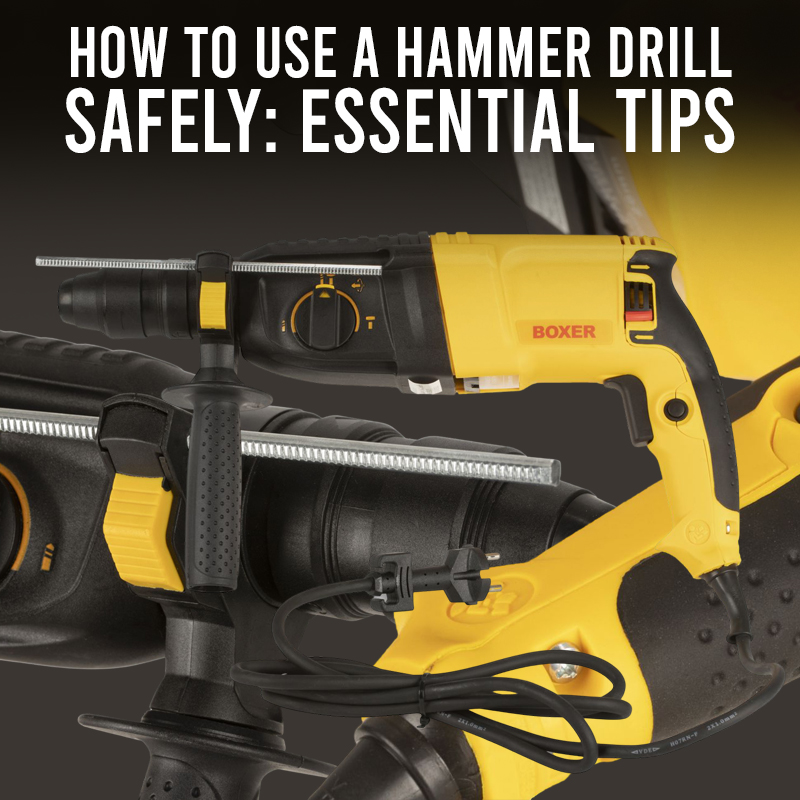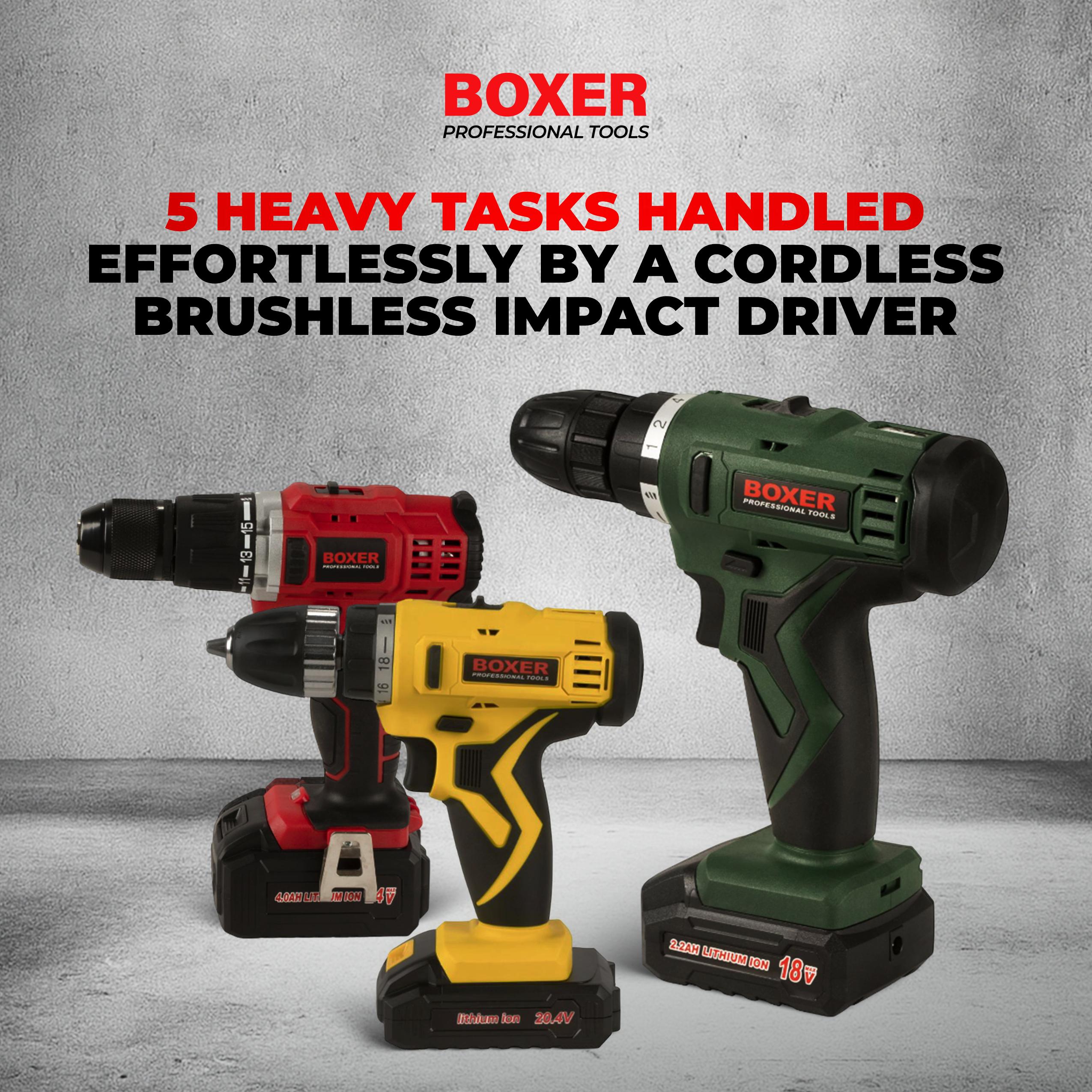
How to Use a Hammer Drill Safely: Essential Tips
Hammer drills are indispensable tools for professionals and DIY enthusiasts alike, offering the power and versatility to tackle a variety of tasks, from drilling into concrete and masonry to driving screws and chiseling. However, their immense power demands a heightened focus on safety to prevent accidents and injuries. Boxer Tools, a trusted name in professional and industrial tool manufacturing and wholesale distribution in Poland, understands the importance of safe tool operation. In this comprehensive guide, we will delve into the essential tips for using a hammer drill safely, ensuring you can accomplish your projects with confidence and avoid any mishaps.
Understanding the Hammer Drill
Before we embark on the safety journey, it's crucial to familiarize ourselves with the hammer drill and its unique features. A hammer drill, often referred to as a rotary hammer or impact drill, combines the rotary motion of a conventional drill with a hammering action. This hammering action delivers rapid blows to the drill bit, enabling it to penetrate tough materials like concrete and brick with ease.
Key Components of a Hammer Drill:
- Motor: The powerhouse of the hammer drill, providing the rotational and hammering energy.
- Chuck: The clamping mechanism that secures the drill bit in place.
- Mode Selector: Allows you to switch between drilling, hammering, and chiseling modes.
- Depth Stop: A helpful feature to control the drilling depth.
- Side Handle: Offers additional control and stability during operation.
- Trigger: Controls the drill's speed and activation.
Essential Safety Tips
Personal Protective Equipment (PPE):
- Safety Glasses or Goggles: Protect your eyes from flying debris and dust.
- Hearing Protection: Reduce the risk of hearing damage from prolonged exposure to loud noise.
- Dust Mask or Respirator: Safeguard your lungs from inhaling harmful dust particles.
- Gloves: Provide a better grip and protect your hands from abrasions and vibrations.
- Sturdy Footwear: Ensure proper foot protection and stability.
Pre-Operation Checks:
- Inspect the Hammer Drill: Before each use, thoroughly check the hammer drill for any signs of damage, including cracks, loose parts, or frayed cords.
- Secure the Drill Bit: Ensure the drill bit is properly inserted into the chuck and tightened securely.
- Test the Drill: Briefly run the hammer drill in a safe area to confirm it's functioning correctly.
Safe Work Area:
- Clear the Area: Remove any obstacles, debris, or tripping hazards from your work area.
- Secure Workpiece: If possible, clamp or secure the workpiece to prevent it from moving during drilling.
- Stable Footing: Maintain a stable and balanced stance to avoid losing control of the hammer drill.
- Adequate Lighting: Ensure the work area is well-lit to enhance visibility and prevent accidents.
Drilling Techniques:
- Select the Right Drill Bit: Choose a drill bit suitable for the material you're drilling into. Carbide-tipped bits are ideal for concrete and masonry.
- Start Slowly: Begin drilling at a slow speed and gradually increase it as needed.
- Apply Steady Pressure: Apply firm but even pressure to the hammer drill to maintain control and prevent the bit from binding.
- Avoid Excessive Force: Let the hammer drill do the work. Excessive force can cause the bit to overheat or break.
- Clear Dust and Debris: Periodically stop drilling to clear away dust and debris from the hole.
- Use the Depth Stop: If available, utilize the depth stop to control the drilling depth and avoid drilling too deep.
Handling and Storage:
Disconnect Power: Always disconnect the hammer drill from the power source when not in use, changing bits, or making adjustments.
Carry with Care: When carrying the hammer drill, hold it by the handle with the bit pointing downwards.
Store Properly: Store the hammer drill in a dry, secure location, out of the reach of children and pets.
Advanced Safety Considerations
- Ground Fault Circuit Interrupter (GFCI): When working outdoors or in damp conditions, plug the hammer drill into a GFCI-protected outlet to reduce the risk of electric shock.
- Extension Cords: If using an extension cord, ensure it's rated for the power requirements of the hammer drill and in good condition.
- Kickback: Be prepared for the possibility of kickback, which can occur if the drill bit binds or encounters a hard object. Maintain a firm grip and control of the hammer drill to minimize the impact of kickback.
- Overheating: If the hammer drill becomes hot to the touch, stop using it and allow it to cool down before resuming operation.
- Professional Assistance: For complex or large-scale projects, consider seeking the assistance of a qualified professional.
Boxer Tools: Your Partner in Safety
At Boxer Tools, we prioritize safety and strive to provide tools that meet the highest standards of quality and performance. Our hammer drills are designed with safety in mind, featuring ergonomic designs, robust construction, and advanced safety features. We are committed to empowering professionals and DIY enthusiasts with the tools and knowledge they need to achieve their goals safely and efficiently.
Hammer Drill Safety FAQs
1. Can I use a regular drill bit in a hammer drill?
While technically possible, it's not recommended. Regular drill bits are not designed to withstand the hammering action and may break or become damaged. Always use drill bits specifically designed for hammer drills.
2. What should I do if the drill bit gets stuck?
If the drill bit gets stuck, immediately stop the hammer drill and disconnect it from the power source. Attempt to carefully loosen the bit by rotating the chuck in the opposite direction. If the bit remains stuck, seek professional assistance.
3. How often should I replace my hammer drill bits?
The lifespan of a hammer drill bit depends on several factors, including the type of material being drilled, the frequency of use, and the drilling technique. Inspect the bit regularly for signs of wear and tear, such as dullness or chipped edges. Replace the bit when it shows signs of significant wear or if its performance deteriorates.
4. Can I use a hammer drill to chisel?
Yes, many hammer drills have a chiseling mode that allows you to use them for light chiseling tasks. However, for heavy-duty chiseling, it's recommended to use a dedicated chisel or a rotary hammer with a chiseling function.
5. What safety features should I look for when buying a hammer drill?
When choosing a hammer drill, prioritize models with safety features such as an ergonomic design, a non-slip grip, a side handle for added control, a depth stop, and overload protection.
By adhering to these essential safety tips and prioritizing safe work practices, you can harness the power of a hammer drill with confidence and minimize the risk of accidents. Remember, safety is a shared responsibility. As a leading provider of professional and industrial tools, Boxer Tools is dedicated to promoting safety awareness and ensuring our customers have the resources they need to work safely and effectively.
Remember, Boxer Tools is your trusted source for high-quality hammer drills and other professional tools. Our commitment to safety and customer satisfaction sets us apart. Choose Boxer Tools for all your tool needs and experience the difference.
By following these safety guidelines and choosing Boxer Tools as your trusted partner, you can confidently tackle any project, knowing you have the tools and knowledge to work safely and efficiently. Remember, safety is paramount, and with the right tools and practices, you can achieve outstanding results without compromising your well-being.
Copyright © 2025 Boxertools | Powered By Orance Media Group








